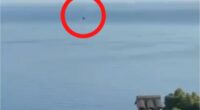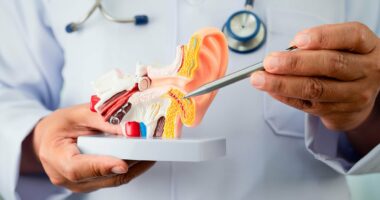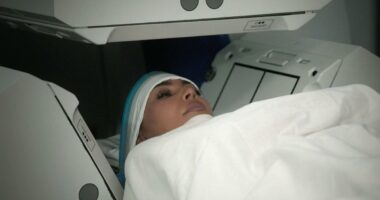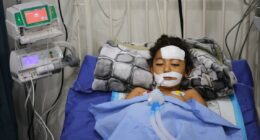Share this @internewscast.com
Health officials across California are asking people to stay away from wild animals after two children contracted a brain-eating parasite.
A CDC report this week revealed a 14-year-old boy and 15-month-old boy suffered from a B. procyonis infection in September 2024 in Los Angeles, prompting a public alert by the agency.
B. procyonis infection, also known as raccoon roundworm infection, is a parasitic disease caused by the roundworm Baylisascaris procyonis that is found and spread by raccoon feces.
In rare cases, it can also infect and be passed on by pet dogs.
The infection can cause fatigue, liver enlargement, irritability, speech deficits, seizures, vision changes, potential blindness, coma and in extreme cases, death.
Despite its life-threatening effects, it remains unknown how many people contract the infection and die from it every year due to its rarity.
While the teenager made a complete recovery, the toddler was left with severe cognitive, motor, and visual impairments due to a delay in diagnosis and treatment.
As a result, the CDC has issued a health concern statement and asked parents to ensure their children stay away from raccoons and their feces, not place contaminated objects or fingers into their mouths and practice good hygiene.

A 14-year-old teenager and 15-month-old toddler ended up suffering from a B. procyonis infection in September 2024 in Los Angeles (stock image)
In May 2024, the teen, who is autistic and has an eating disorder that causes compulsive craving and consumption of non-food items, was brought to Children’s Hospital Los Angeles.
He was hospitalized for a week after his parents observed behavioral changes including sleepiness, decreased activity, confusion and unsteady gait.
A series of tests showed he had 14 percent higher white blood cells in his body than the standard count, indicating his body was fighting an infection.
As his symptoms continued to worsen, doctors ordered an MRI of his brain.
During examination, they noticed numerous areas of his brain appeared brighter or more visible than others.
Combined with his symptoms and increased white blood cells in his blood test, they concluded that he was suffering from a B. procyonis infection.
Similarly, the toddler, who had met all of his developmental goals and was healthy, was hospitalized in June 2024 for behavioral changes, lethargy, muscle weakness and gait instability.
A subsequent blood test also showed that his white blood cells were 53 percent higher than the standard count.

Additionally, his test results also showed that he had 16 percent more white blood cells in his cerebrospinal fluid (the fluid surrounding the brain and spinal cord), which suggested he had a brain infection.
Much like the 14-year-old teenager, the young child’s MRI also showed abnormalities in multiple parts of his brain but had not been diagnosed with the raccoon roundworm infection
He was treated with an infusion of immune-supporting antibodies, steroids and an antibody medication.
The 15-month-old also underwent plasmapheresis, a process that separates blood into plasma and cells using a machine. It is often used to treat conditions where the body’s immune system mistakenly attacks its own tissues.
He received treatment at two different hospitals.
After six weeks, the toddler was sent home with a feeding tube, a plan to slowly reduce the steroid dose he was receiving and his parents were asked to set up follow-up appointments.
However, in September 2024, the parents rushed him to Children’s Hospital LA in an ambulance as the toddler’s symptoms continued to worsen.
Doctors at the hospital noticed the child was showing similar symptoms as the teenager and had a high white blood count, prompting them to suspect a B. procyonis infection.
During an exam, doctors found the parasitic roundworm Baylisascaris procyonis in the toddler’s eye and killed it with a focused laser.
Both the teenager and toddler were treated for six weeks with albendazole (an anthelmintic drug that kills parasitic worms) and corticosteroids (an anti-inflammatory drug to manage symptoms like headaches and seizures).

B. procyonis infection, also known as raccoon roundworm infection, is a parasitic disease caused by the roundworm Baylisascaris procyonis

Raccoons become infected with the roundworm either by eating its eggs during foraging, feeding and grooming
Raccoons become infected with the roundworm either by eating its eggs during foraging, feeding and grooming or consuming rodents, rabbits and birds that are infected with the parasite already.
Once infected, roundworm eggs can pass in the feces of the animals and mix with soil around human property.
Young children are at the highest risk of developing a Baylisascaris infection as they are most likely to play with the contaminated soil and put their infected fingers into their mouths, allowing the roundworm eggs to enter their body.
According to the CDC, the teenager’s family had frequent visits from numerous raccoons near the property and noted that neighbors regularly left food out for community cats, which can attract raccoons.
Additionally, officials also found raccoon feces all around the property and believe that it may have contaminated the soil around their house.
As a result, city health officials conducted multiple de-infestations around their house but due to the frequency of raccoon visits, the family was forced to move.
While officials did not find any evidence of raccoons around the toddler’s house, they were told by family members that the child had a tendency to eat soil and bark mulch at their residence, local parks and the beach.
















